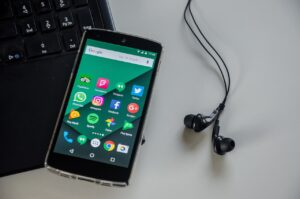Introduction
Android, the world’s most widely used mobile operating system, offers a rich and diverse ecosystem of applications. While this diversity is a strength, it also presents challenges, particularly when it comes to background services and battery optimization. In this article, we will explore how Android handles background services, the strategies it employs to optimize battery life, and the impact on user experience.

-
Background Services in Android
1.1. What Are Background Services?
Background services in Android refer to processes or tasks that continue to run even when an app is not actively in use or visible on the screen. These services enable various functionalities, such as receiving notifications, syncing data, and performing updates, without requiring constant user interaction.

1.2. Common Uses of Background Services
Background services are essential for a wide range of applications and features, including:
- Messaging Apps: To receive and display messages in real time.
- Social Media Apps: For notifications, updates, and content syncing.
- Email Apps: To check for new emails and deliver notifications.
- Weather Apps: To fetch and display the latest weather information.
- Fitness Apps: To track physical activity and record data.
- Location-Based Apps: To provide location-based services and geofencing.
- Media Streaming: For continuous playback of audio and video content.
-
Battery Optimization in Android

2.1. The Importance of Battery Optimization
Battery life is a critical aspect of the user experience on mobile devices. Users expect their smartphones to last throughout the day without frequent recharging. Android’s battery optimization strategies aim to extend battery life while ensuring that essential background services continue to function.
2.2. Doze Mode
Doze Mode is a battery-saving feature introduced in Android 6.0 (Marshmallow). It significantly reduces background activities when a device is in a stationary state, such as when the screen is off and the device is not in use. During Doze Mode, background services are temporarily suspended or limited to conserve power.

2.3. App Standby
App Standby is another battery optimization feature that restricts background services for apps that haven’t been used for an extended period. It limits network access and background processing to reduce power consumption. However, high-priority services, such as messaging and alarms, remain active.
2.4. Adaptive Battery
Adaptive Battery, introduced in Android 9.0 (Pie), uses machine learning to analyze user behavior and prioritize which apps are allowed to run background tasks. It restricts less frequently used apps from consuming excessive resources, optimizing battery life.
III. Handling Background Services Efficiently
3.1. Service Lifecycle
Android follows a well-defined lifecycle for services. Developers need to understand this lifecycle to ensure that services are created, started, and stopped appropriately, minimizing resource usage.

- onCreate(): This method is called when a service is first created. Initialization and setup tasks should be performed here.
- onStartCommand(): This method is invoked when a client (e.g., an activity) starts the service. Developers must manage the service’s behavior during its execution.
- onBind(): This method allows components (e.g., activities) to bind to a service. It’s crucial for communication between the service and other app components.
- onDestroy(): This method is called when the service is no longer needed. Developers should release resources and clean up here.
3.2. Intent Service
Intent Service is a subclass of Service that simplifies the implementation of background services. It automatically handles the service lifecycle and ensures that tasks are processed sequentially in a background thread. This prevents resource-intensive operations from blocking the main UI thread.
3.3. Job Scheduler
Job Scheduler is an Android API introduced in Android 5.0 (Lollipop) that allows developers to schedule background tasks, such as data synchronization or updates, based on certain conditions. JobScheduler optimizes power usage by batching and executing tasks efficiently.

3.4. Work Manager
Work Manager is a modern Android library for managing background tasks. It provides a consistent API for scheduling tasks with options for defining constraints, such as network availability or charging status. WorkManager intelligently chooses the most appropriate execution method, whether it’s immediate, deferred, or in a batch.
-
Background Location Services
4.1. Location Tracking
Location-based services are essential for various apps, including navigation, weather, and location sharing. However, continuous background location tracking can significantly impact battery life.
4.2. Fused Location Provider
The Fused Location Provider is an Android API that optimizes location tracking by combining various location sources, including GPS, Wi-Fi, and cellular data. It uses algorithms to minimize power consumption while providing accurate location updates.

4.3. Location Permissions
To access a device’s location, apps must request location permissions from the user. Android allows users to grant location access only while the app is in use, while the app is in the background, or deny access entirely. Users can also revoke location access at any time.

-
User Control and Transparency
5.1. Battery Usage Stats
Android provides users with detailed information about battery usage by apps. Users can access battery usage stats to identify which apps consume the most power, including background activities.
5.2. Battery Saver Mode
Android offers a Battery Saver mode that users can enable to limit background activities and extend battery life when their device’s battery level is low. In Battery Saver mode, background sync, location services, and push notifications may be temporarily restricted.
5.3. App Power Optimization
Users can individually optimize app power usage by navigating to the Battery section in the device’s settings. Here, they can select specific apps and choose whether to allow or restrict background activity.

-
Developer Best Practices
6.1. Minimize Background Activity
Developers should strive to minimize background activity whenever possible. This includes batching updates, reducing polling frequency, and optimizing network requests to minimize data transfer.
6.2. Use Alarm Manager Wisely
Alarm Manager is an Android API for scheduling tasks at specific times or intervals. Developers should use AlarmManager judiciously, as frequent alarms can wake up the device, consuming power.
6.3. Respect Doze Mode and App Standby
Developers should be aware of Doze Mode and App Standby restrictions and design their apps to work efficiently within these limitations. This may involve using high-priority Firebase Cloud Messaging (FCM) for push notifications or optimizing data sync intervals.

VII. The Impact on User Experience
7.1. Balancing Act
Android’s approach to handling background services and battery optimization is a balancing act between preserving battery life and ensuring that essential background functionality remains intact. Striking the right balance is crucial to delivering a positive user experience.
7.2. App Responsiveness
Users expect apps to remain responsive and up-to-date, even when not actively in use. Properly optimized background services contribute to a seamless user experience, allowing notifications, updates, and data syncing to occur without manual intervention.
7.3. User Empowerment
Android empowers users by providing visibility and control over how apps consume battery resources in the background. This transparency allows users to make informed decisions about which apps they want to grant background activity privileges.

VIII. Conclusion: Optimizing the Android Experience
In conclusion, Android’s approach to handling background services and battery optimization reflects the platform’s commitment to delivering an optimized and user-centric experience. While background services are essential for many app functionalities, they must be managed efficiently to minimize battery drain and ensure device longevity.
Developers play a pivotal role in this ecosystem by implementing best practices, utilizing modern APIs like JobScheduler and WorkManager, and respecting user preferences for background activity. The ongoing collaboration between Android, app developers, and users ensures that Android continues to evolve as a platform that strikes the right balance between functionality and energy efficiency.


